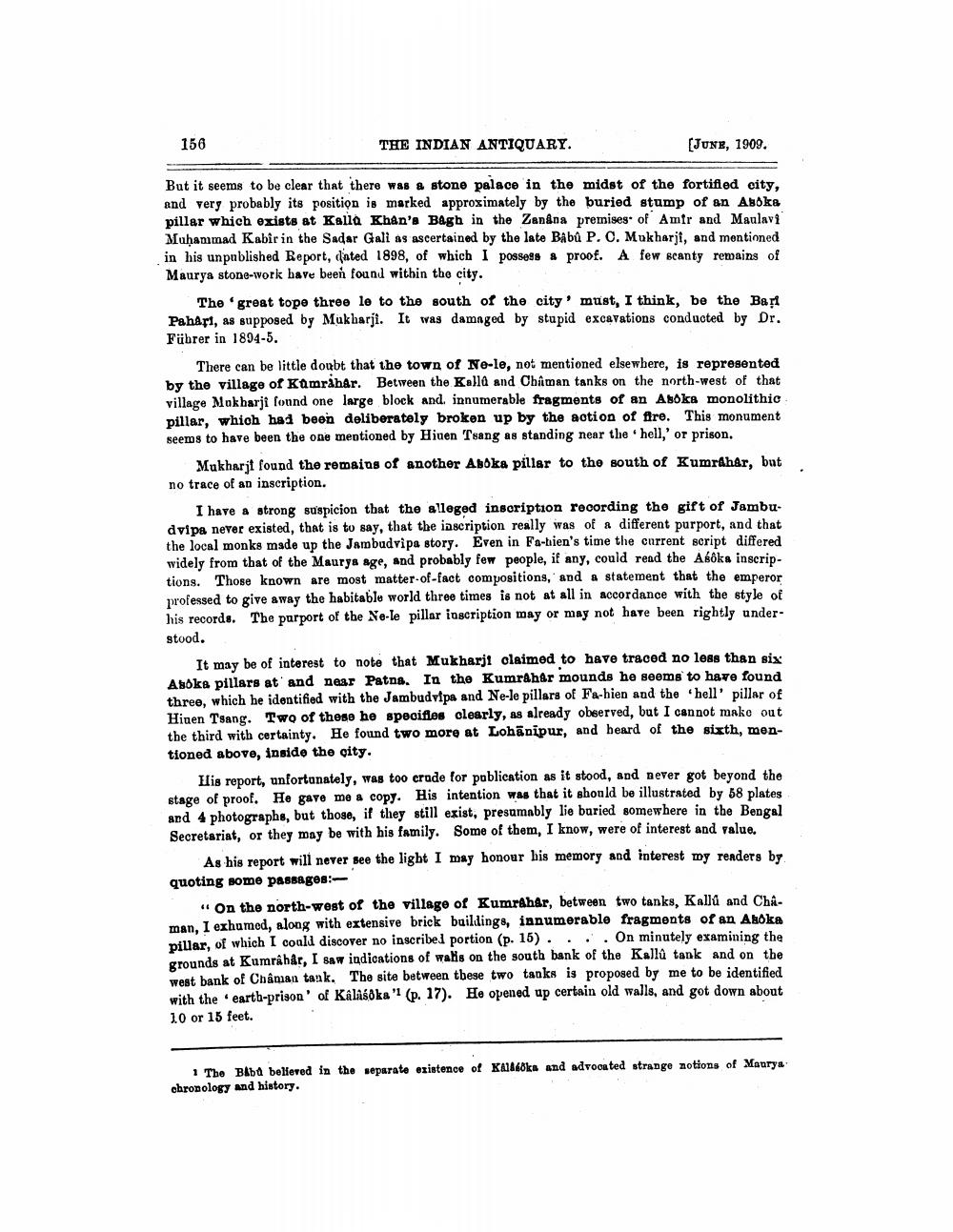________________
156
THE INDIAN ANTIQUARY.
(JUNE, 1909.
But it seems to be clear that there was a stone palace in the midst of the fortified city, and very probably its position is marked approximately by the buried stump of an Abbka pillar which exists at Kalla Khan's Bagh in the Zanana premises of Amir and Maulavi Muhammad Kabir in the Sadar Gali as ascertained by the late Babû P. O. Mukharji, and mentioned in his unpublished Report, cated 1898, of which I possess & proof. A few scanty remains of Maurya stone-work have been found within the city.
The great tope three le to the south of the city' must, I think, be the Bari Pahari, as supposed by Mukharji. It was damaged by stupid excavations conducted by Dr. Führer in 1894-5.
There can be little doubt that the town of No-le, not mentioned elsewhere, is represented by the village of Kumråhår. Between the Kalla and Chaman tanks on the north-west of that village Makharji found one large block and innumerable fragments of an Asoka monolithic pillar, which had been deliberately broken up by the action of fire. This monument seems to have been the one mentioned by Hiuen Tsang as standing near the hell,' or prison.
Mukharjt found the remains of another Abbka pillar to the south of Kumrdher, but no trace of an inscription.
I have a strong suspicion that the alleged inscription rooording the gift of Jambudvipa never existed, that is to say, that the inscription really was of a different purport, and that the local monks made up the Jambadvipa story. Even in Fa-hien's time the current script differed widely from that of the Maurya age, and probably few people, if any, could read the Abôks inscriptions. Those known are most matter-of-fact compositions, and a statement that the emperor professed to give away the habitable world three times is not at all in accordance with the style of his records. The purport of the Ne-le pillar inscription may or may not have been rightly understood.
It may be of interest to note that Mukharjt claimed to have traced no less than six Asoka pillars at and near Patna. In the Kumraher mounds he seems to have found three, which he identified with the Jambudvipa and Ne-le pillars of Fa-bien and the hell' pillar of Hinen Tsang. Two of these he specifies clearly, as already observed, but I cannot make out the third with certainty. He found two more at Lohānipur, and heard of the sixth, men tioned above, inside the city.
His report, unfortunately, was too crude for publication as it stood, and never got beyond the stage of proof. He gave me a copy. His intention was that it should be illustrated by 58 plates and 4 photographs, but those, if they still exist, presumably lie baried somewhere in the Bengal Secretariat, or they may be with his family. Some of them, I know, were of interest and value.
As his report will never see the light I may honour his memory and interest my readers by quoting some passages:
"On the north-west of the village of Kumrahar, between two tanks, Kalla and Chiman, I exhumed, along with extensive brick buildings, innumerable fragments of an Aboka pillar, of which I could discover no inscribel portion (p. 15). .. On minutely examining the grounds at Kumråhår, I saw indications of walls on the south bank of the Kallû tank and on the west bank of Chaman tank. The site between these two tanks is proposed by me to be identified with the earth-prison of Kalasoka" (p. 17). He opened up certain old walls, and got down about 10 or 15 feet.
1 The Bibd believed in the separate existence of KAABkn and advocated strange notions of Maury chronology and history.




